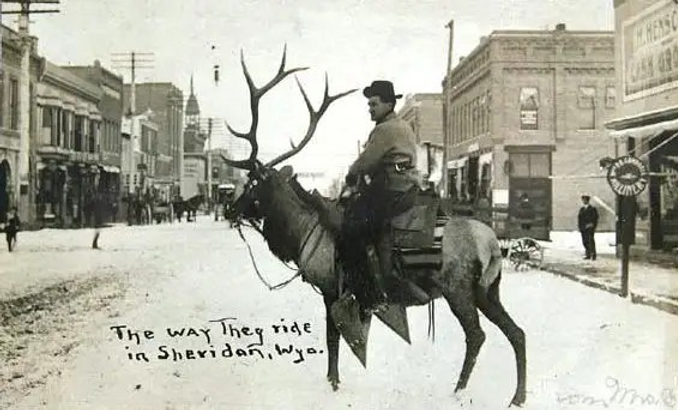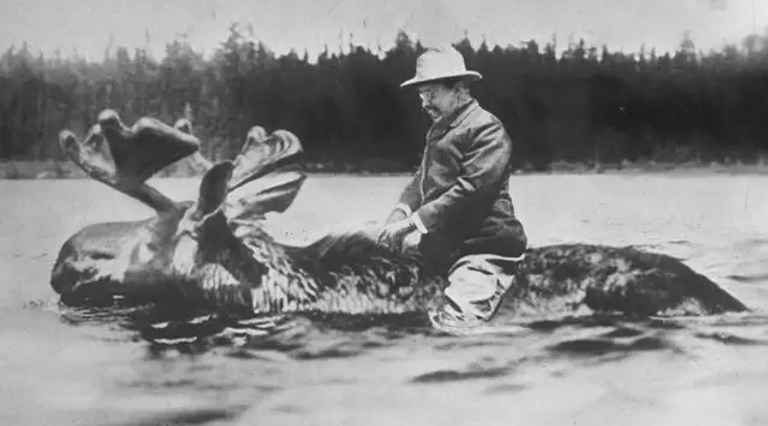Riding Cervids
Throughout history, people have ridden members of the Cervidae family—reindeer (caribou), elk, and moose—in certain regions of the world. However, these occurrences are rare compared to the widespread use of horses, mules, donkeys, and camels for riding purposes.
Deer are not commonly ridden for two main reasons:
-
Most species are light-boned and poorly suited to carrying a load on their backs. They have long, slender legs designed for running and leaping rather than carrying the weight of a rider. Attempting to ride a deer could cause injury to both the animal and the person.
-
All deer species are undomesticated with a skittish and unreliable temperament, making them more dangerous to ride than domestic stock.
Of course, there are some interesting exceptions. Let's explore the hazardous (but sometimes humorous) history of riding deer around the world.
Reindeer Riding in the Far North
Reindeer (Rangifer tarandus), also known as caribou in North America, have been historically ridden by some indigenous peoples of the Arctic, such as the Sámi people of northern Scandinavia and the Nenet people of Siberia. These nomadic communities have a deep cultural connection with reindeer herding and have developed techniques for riding and harnessing them. These relatively sturdy deer can function well as both pack and riding animals. There, the Tsaatans or Dukha people begin training reindeer to carry children when the reindeer are about two years old, and by the age of three, the reindeer are usually strong enough to carry adults and pack loads weighing between 30 and 40 kg.
Reindeer are typically not ridden for long distances or as extensively as horses anywhere in the world. According to Dr. Sheldon Jackson, the Commissioner of Education in Alaska and a Presbyterian minister in the early 1900s, Alaskan immigrants such as miners generally came to the opinion that reindeer riding was "very inconvenient and unsafe."
Saddling Elk in the Old West
Another robust species of deer that can, in theory, be saddle-trained is the elk (Cervus elaphus). While never commonly used for riding, there are historical accounts of Native American tribes, such as the Nez Perce and Crow, occasionally riding elk for short distances or using them as pack animals. However, these instances were relatively rare, and elk were not extensively domesticated or used for transportation purposes like horses.

Because horses were available as a superior alternative, elk-riding fell by the wayside and became merely a novelty or hobby featured on early American postcards like the one shown above. Elk riding was sometimes performed as a spectacle during Wild West shows as well.
Moose as Military Mounts?
Moose (Alces alces), the largest species in the deer family, have been ridden in parts of Scandinavia and Russia (where they are called elk).
There have been repeated attempts to domesticate moose for riding, but none have been completely successful. It was first officially proposed as a military measure in Russia by zoologist Alexander von Middendorff, who wrote a convincing letter to the tsar in 1869:
"Even the civilized Europe these days has failed to domesticate the moose, the animal that doubtlessly can be of great utility. Our government ought to apply all possible efforts toward the domestication of this animal. This is doable. The reward would be great, and so would be the glory."
Alas, Middendorff's idea never really left the ground, but during World War II, the Russian army revived the notion of using moose as mounts to traverse cold and snowy areas that horses could not cope with.
"Large, strong, and agile in snow, moose seemed like the perfect fit for the Communist cavalry. However with the onset of the Soviet–Finnish war in 1939 followed closely by WWII, the entire idea of a calvary was abandoned," reports Atlas Obscura via Slate.
Sweden also attempted to train moose as combat mounts in the 1930s. In both cases, the moose were too unsteady under fire to be really useful.
Russian Moose Farming
The Kostroma Moose Farm, also known as the Kostroma Moose Nursery, is a unique facility located in the Kostroma Oblast region of Russia. It is dedicated to the breeding and training of moose, with a focus on preserving and studying these animals. You can see some early footage of the establishment in the video above. Established in 1963, the farm has played a significant role in moose conservation and research. Its primary objective is to raise moose in captivity and study their biology, behavior, and domestication potential. The farm is particularly known for its successful efforts in taming and training moose for various purposes, including forestry and tourism.
One of the main goals of the moose farm is to develop moose as draft animals for the forestry industry. Due to their size, strength, and ability to navigate difficult terrain, moose can be potentially useful for hauling logs in regions where traditional means of transportation might be challenging. The farm conducts experiments and training programs to assess the feasibility and effectiveness of using moose for forestry work.
In addition to their practical applications, the Kostroma Moose Farm also serves as a tourist attraction. Visitors have the opportunity to observe moose up close, learn about their biology and behavior, and even witness demonstrations of trained moose performing various tasks. The farm provides educational programs to raise awareness about moose conservation and the importance of preserving natural habitats.
Conclusion
To ride a large deer would be an impressive sight and a dream come true for some people. Deer wrangling has been considered quite an accomplishment through the ages because dealing with large, semi-domesticated animals is no small feat. However, with the exception of the reindeer herding societies that live in close association with their animals, deer are a very impractical choice of mount. Most of us will have better luck (and fewer broken bones) if we stick to riding domestic horses and their relatives.

References
Annual Report on Introduction of Domestic Reindeer Into Alaska... Vol. 9. US Government Printing Office, 1900.
Geddes, Arthur. "Scots Gaelic Tales of Herding Deer or Reindeer." Folklore 52 (1951).
Rydell, R. W., & Kroes, R. (2010). Buffalo Bill in Bologna: the Americanization of the world, 1869-1922. University of Chicago Press.
Bodansky, R. (2014). Release from developmental arrest—early childhood trauma: The case of Mrs. E. Psychoanalytic Inquiry, 34(3), 191-203.